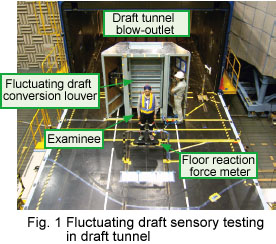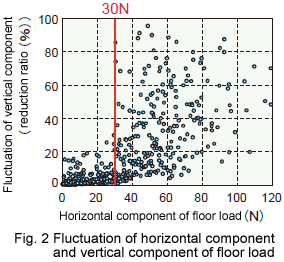Train drafts are induced when vehicles pass through stations, and their strength depends on the train speed. For this reason, as train speeds increase, it is necessary to consider beforehand the impact that train drafts exert on people on station platforms and conduct related safety verification/examination.
The RTRI carried out examinee testing in a draft tunnel (Fig. 1) focusing on the fluctuating draft seen during the passage of the front-end part of trains and the sustainable steady-state draft that occurs after the passage of trains (the features of train draft caused by high-speed vehicles), and investigated the relationship between draft velocity and the force a person feels from the draft (i.e., the horizontal component of the floor load), as well as the relationship between load and sway of attitude. It was found that both fluctuating drafts and steady-state drafts cause loads that are directly proportional to the square of the draft’s velocity, and that fluctuating drafts with high frequencies cause reduced load, which in turn reduces the sway of attitude. In addition, immediately before the sway of attitude begins, the vertical component of the floor load fluctuates rapidly, and its horizontal component at this point for a person who is most likely to sway was 30 N (Fig. 2).
Based on the results obtained from the test, the RTRI proposed a train-draft evaluation technique for station platforms from an ergonomic point of view (Fig. 3). First, draft velocities during the passage of trains are measured using a draft velocity meter with a response frequency of 10 Hz. The load waveform exerted on the human body is determined by processing the square of the draft velocity to reduce high-frequency components using a filter for train-draft evaluation that has characteristics determined from draft tunnel testing. If the maximum value is equal to or less than the reference value (30 N), it is concluded that the person is stable, and the train draft is within a safe range. Using this evaluation technique, we can conduct safety assessment that corresponds with reality for train drafts on station platforms.
|





